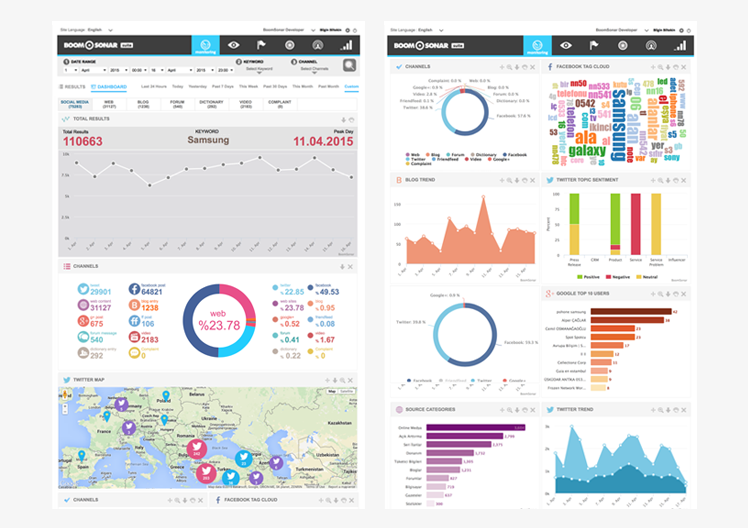8 Must Ask Questions for a Successful Social Media Competitor Analysis
Social media is tough for business competition, and it’s getting tougher each year. Now the large companies don’t always have the upper hand in marketing and advertising with their budgets, extensive teams and prestigious agencies. A small company or a startup with a strong and catchy social media plan may take part at any competitive level. Of course this doesn’t happen with just inspiration. You should listen, monitor and analyze the competition and get intelligence about their social media activity. Social media monitoring is the heart of this intelligence gathering.
It’s better to see the social media competitor analysis as a way of exploring your path, surroundings, gathering intelligence about everything that you are interested in, self-discovery and orientation that widens your horizon. In one sentence, it means gathering information about your position in the market.
What does competitor analysis mean on social media?
Competitor analysis is not so easy. B2B marketers usually have difficulties when it comes to competitor analyses. Most B2B marketing is done through direct communication. With no chance to monitor these channels, getting the complete insights about actions of your competitors difficult. Compared to this, the online activities are easier to follow, especially when you use a compatible social media monitoring tool to listen, monitor and analyze. From your competitors’ official websites to customer complaints on any social media channel, you can have intelligence about your industry.
Why you should analyze the competition?
Seeing the weak and strong points of your competitors is important for your strategy and the future of your business. This also applies to agencies which provide marketing, PR and reputation management services. By looking at your opposition, you can find the changes you have to make, get some creative ideas and explore different fields where you can take action. Monitoring the competitors may give you the possibility to identify the influencers in your industry and their influence range. If an influencer criticizes the opposition about a subject that you have the upper hand, this situation can be used to your advantage. You can show to the influencer how your products or services are better compared to your competitor.
Who are your competitors?
Define your competitors before you start competitive intelligence gathering. First step is to use what you already know. The competitors you have already identified should be your starting point. Even if you don’t know any competitors as a startup company or if you are a monopoly in your industry, try to analyze the most similar company to yours for competitior analysis or create an imaginary company for a projection analysis.
For the best results, try to proceed with the analysis in two stages. In the first stage, limit your analysis to the market leaders and direct competitors in your sector. This stage helps you to analyze your core competitors, gather your primary insights and see the direct competition.
Limiting your analyses permanently to the first stage may limit your future perspective. So, the next stage is broadening the frame. List the indirect competitors and the newcomers and monitor them. Maybe you don’t have straight business relevance with them, but you can still monitor them to keep being informed of their actions.
Beside the competitors, another group of businesses to monitor and analyze is sub-industry companies and brands, such as suppliers and retailers. There might be products or services out there with different features serving similar purposes and that means they are targeting a similar market segment.
So, you have a definition of your business and competitors. Also you have been listing your potential competitors and analyzed them according to your own qualifications. Now, you want to gather detailed intelligence about how they are being engaged in the social media and what people are saying about your competition.
Where are your competitors active?
After you have defined the range of your competition, focus on when and where they are engaging. Most of the businesses are starting with the main social media channels like Facebook, Twitter, Google + and LinkedIn (for B2B businesses). Every bit of information can be useful, but in the range of existing sources on the web, start with their web presence. If they have any, explore their blogs.
Afterwards, check out which social media channels your competitors have presence and are active. If they have a good and strong community, you should probably be present on the same channel, since your target audience is most probably on this channel. Monitoring your target segment on various social media channels can lead you to other competitors or potential ones.
Needless to say, if your competitors are on the particular networks and they are active with good fan and follower numbers, be there! Usually, most businesses are loyal to Twitter, Facebook, Google+ and LinkedIn and don’t engage on other channels. This might be a good opportunity to reach your audience outside these channels.
When framing your competition, between all the social media channels you should pay special attention to LinkedIn. You can collect information on LinkedIn company pages from number of employees and followers to their growth. What kind of products or services do they offer? You can see how they are connected to the competition. Beside competitors’ social media accounts, you can check their employees’ social media accounts, too. Any informative content like whitepapers, reports, studies or presentations on Slideshare can provide valuable information for you.
What are their engagement rates?
Engagement rate is maybe the most critical metric among all the social media metrics. Number of likes, shares and comments per post divided by the number of audience gives you the engagement rate. What is your competitors’ engagement rate and if it is high and increasing consistently, how are they doing it? Monitor their content strategy and relevancy with your own business strategy. See how you can position yourself against their strategy and create creative and competitive contents. With a lacking or passive presence on social web, it is impossible to get any user engagement.
What content types are they posting?
Competitor analysis is about the competition, do not focus only on yourself. When you look at the content types your competitors are posting, analyze and compare them with your own to see if they are efficient or not. Monitor and analyze competitor posts to see how their posts generate buzz. Besides the usual posts including contents like photos and videos other options exist, too; such as polls, contests, questions, trivia, endorsements and so on. Monitor these posts with extra attention.
A company or brand can also share news articles, event calls or blog posts with their followers. Diversity depends on creativity and motivation in this situation. Day by day, new content types are getting in trends. Another question to ask here is: Do they repost other brands’ contents or do they create their own content by using links, hashtags and mentions frequently? Are they using personalized hashtags or mostly visually intense content types? Do they post their own videos? How are they conducting the visual content with texts?
Social media monitoring tools give you the ability to analyze what topics are trending within the industry. The information about engagement of the contents posted by competition allows you to see the trends occurring in your sector.
Are your competitors frequently sharing posts on their pages? How frequently they share? Do they post similar content or is each content unique within the time periods you are analyzing?
How is their voice?
The wording of the competitors’ social media presence on Twitter profile or Facebook page is a triggering factor for conversations and traffic. You should analyze how they are describing and presenting themselves on various channels.
For your own presence on social web, you need to differentiate from others by deciding your own wording. Different channels mean different tones. Companies’ or brands’ self-descriptions on LinkedIn are based on the channel’s B2B purposes and should be formal, meanwhile Twitter content and layout asks for a more relaxed language. This implies that the wording and style of presentation will differ based on the media they use, so yours should be, too.
What will you get at the end of the day?
One of the most important reasons of having an SMM tool is to listen to and monitor the conversations about everybody. People are expressing their opinions on products, brands and companies on social media, blog, web sites, forums and other channels. You have the opportunity to get the essential information by monitoring the whole conversation.
With the data in your hand, every department of your company can come in to play! Your marketing team, product managers, salespeople, PR, customer relations, R&D and many more can benefit from monitoring. Evaluating consumers’ negative or positive opinions and comparing them with your own sentiment score will provide these departments deeper insights about their performance.
You can get the data of your customers talking negative or positive about your competitors, their customers talking likewise about you, and people mentioning both of you in comparison. Every group is very important for your analysis. By this classifying system, you can have results on sentiment score comparisons under the topics concerning your business structure and interests.
During a campaign launch, you can monitor the efficiency of it. It can be done the same way for competitions’ campaigns and you can compare your success with the competitors’. This will give strong clues as to what the potential is, how further you can reach with your campaigns, and on which channels they get more response and positive or press mentions. On the other hand, competition doesn’t mean being enemies. Who knows, when the right opportunity comes, perhaps you can be partners or allies in the future.
A social media monitoring tool like BoomSonar Suite may facilitate your competitor analysis and help your brand stay in competition. BoomSonar real-time web and social media monitoring tool can listen and monitor your brand and competitors’ social media engagement and campaigns. By measuring the sentiment around your competitors’ brand, products and services you can see the picture of what is happening in your industry.


